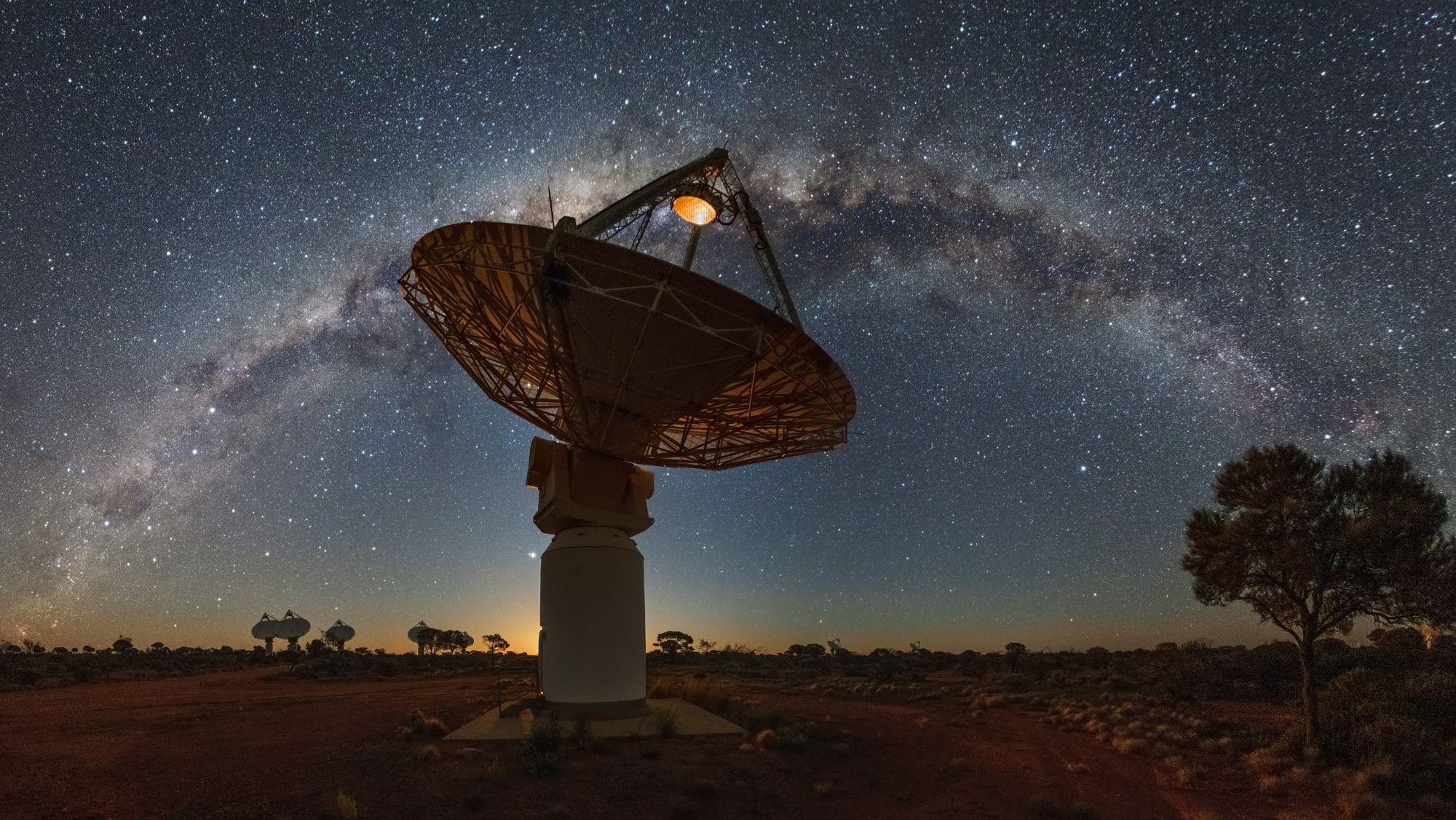

Of all the pyrotechnics that blast through the cosmos, fast radio bursts (FRBs) are among the most powerful—and mysterious. While our radio telescopes have picked up hundreds of known FRBs, radio astronomers recently detected one of the most fascinating bursts yet. Not only does it come from a greater distance than any FRB observed before, it’s the most energetic, too.
A superlative FRB like this defies our already murky understanding of the bursts’ origins. FRBs are sudden surges of radio waves that typically last less than a second, if not mere milliseconds. And they are very, very high-energy: They can deliver as much energy in milliseconds as the sun emits in three days. Despite all that, we don’t know for certain how they form.
The new event, what astronomers lovingly call FRB 20220610A, first appeared as a blip in the Australian Square Kilometre Array Pathfinder, an arrangement of antennae in the desert about 360 miles north of Perth. When astronomers measured the burst’s redshift, they calculated that it left its source about 8 billion years ago, as they described in a paper published today in Science.
After pinpointing the burst’s origin in the sky and following up with visible light and infrared telescopes, the authors managed to develop a blurry image of merging galaxies.
[Related: Two bizarre stars might have beamed a unique radio signal to Earth]
“The further you go out in the universe, of course, the fainter the galaxies are, because they’re farther away. It’s quite difficult to identify the host galaxy, and that’s what they’ve done,” Sarah Burke Spolaor, an astronomer who studies FRBs at West Virginia University, who was not an author of the study.
FRBs aren’t exciting just because they’re loud. To reach us, a burst from outside the Milky Way must traverse millions or billions of light-years of the near-empty space between galaxies. In the process, they’ll encounter an extremely sparse smattering of ionized particles. This is the stuff that prevents the bulk of the cosmos from being completely empty—what astronomers call the intergalactic medium, which might make up as much as half of the universe’s “normal” matter.
“We don’t know much about it, because it’s so tenuous that it’s difficult to detect,” says Daniele Michilli, an astronomer at the Massachusetts Institute of Technology, who also wasn’t a study author.
As an FRB crosses the intergalactic medium on its long voyage, the particles cause its radio waves to scatter, which leaves fingerprints that astronomers can pick apart. In this way, scientists can use FRBs to investigate the intergalactic medium. More faraway bursts like FRB 20220610A could allow astronomers to study the medium across wide swathes of the universe.
[Related: How astronomers traced a puzzling detection to a lunchtime mistake]
“It’s very exciting, definitely one of the great applications of fast radio bursts,” says Ziggy Pleunis, an astronomer who studies FRBs at the University of Toronto, who was also not part of the authors’ group. “Fast radio bursts currently are really the only thing that we know that interacts with the intergalactic medium in a meaningful enough way that we can measure properties.”

In the future, astronomers might even be able to use FRBs to study how the universe expands. To unweave that mystery, however, astronomers will need to detect FRBs from even deeper into the cosmic past than FRB 20220610A. “For a lot of applications, it’s still not quite far away enough,” Pleunis says. “But it certainly bodes well.”
There’s a balancing act involved: Over a sufficiently long distance, the particles in the intergalactic medium will peel an FRB apart until it disperses into background noise. To survive, an FRB must be brighter and more energetic; in turn, by taking stock of how much a burst has dispersed, astronomers can estimate its original energy.
By computing the numbers for FRB 20220610A, they found that it was the most energetic burst Earth has seen so far. (Another recently observed burst, FRB 20201124A, comes within the same order of magnitude, but FRB 20220610A is the record-holder.) A burst with this much energy throws something of a wrench into astronomers’ understanding, such as it is, of what creates FRBs in the first place.
We, again, don’t have a definitive answer to that question. Complicating the question, some FRBs are one-off flashes, while others repeat, hinting that the two types of FRBs may have two different origins. (To wit, FRB 20220610A seems to have been a one-off. But that other high-energy FRB, FRB 20201124A, seems to repeat.)
Nevertheless, astronomers have simulated a few scenarios, largely involving neutron stars. Perhaps FRBs burst from near a neutron star’s surface, or perhaps FRBs erupt from shockwaves through the material that neutron stars throw up.
But when this paper’s authors ran the numbers with their new FRB, they found that neither of those two scenarios could easily create an burst with this much energy—suggesting that theoretical astronomers have even more work to do before they can satisfactorily explain these events.
“What always strikes me about fast radio bursts is, every time we observe a new one, it breaks the mold of previous ones,” Spolaor says.
